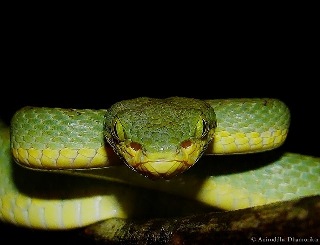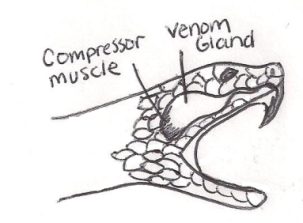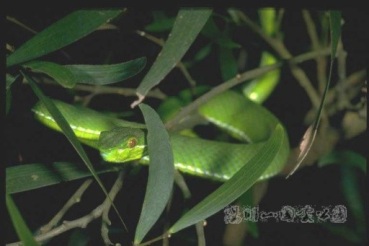Adaptation
Like any creature on Earth, the Bamboo pit vipers have adapted to their environment in order to survive. Here's some adaptations that have made the Bamboo pit vipers so successful in their niche.
The pit organs:
The pit organ is the most unique structure in the Bamboo pit
vipers arsenal. All members of the
Crotalinae subfamily contain this organ,
which sits between the nostrils and eyes. This organ has
the amazing ability to sense infrared heat to track prey. The pit is
able to do this because of the large accumulation of the protein
TRPA1 in the pit organ. This organ gives the pit vipers a
sixth sense of night vision, a very useful adaptation
when hunting prey at night. The pit viper strikes an
animal, and uses its pit organ to track the prey until the venom
takes into affect. If you want to learn more about the
TRPA1 gene and the pit organ, the
Institute for Creation Research website has a great article about this organ.
Venom:
 Pit viper venom is a powerful hunting tool for the pit vipers!
The venom varies between species, but the Bamboo pit viper has
been identified to have hemotoxic venom, which prevents
clotting factors of the blood. When a pit viper strikes,
the venom is ejected through the viper's hollow fangs and injected into the prey.
While the effects are not immediate, in small animals the venom
spreads quickly through the body and the animal eventually
collapses. The Bamboo pit viper, who tracks the animal
closely with its pit organs, is now able to engulf the food.
Without venom it would be pretty hard for the pit vipers to get
any nutrition.
Pit viper venom is a powerful hunting tool for the pit vipers!
The venom varies between species, but the Bamboo pit viper has
been identified to have hemotoxic venom, which prevents
clotting factors of the blood. When a pit viper strikes,
the venom is ejected through the viper's hollow fangs and injected into the prey.
While the effects are not immediate, in small animals the venom
spreads quickly through the body and the animal eventually
collapses. The Bamboo pit viper, who tracks the animal
closely with its pit organs, is now able to engulf the food.
Without venom it would be pretty hard for the pit vipers to get
any nutrition.
Color:
A great tool for protection against predators that the Bamboo pit viper
uses is simple camouflage. Pit vipers come in a wide range
of colors and patterns, and the colors are largely dependent on
where the snakes live. The
bamboo pit vipers distinctive green skin helps it hide from
their
predators and sneak up on their prey
in the green of the jungle foliage.
Imagine how hard it would be for the pit vipers if they were
bright pink! It's a good thing they blend in so well.
Scales:
The Bamboo pit viper's body is covered is scales. Scales
are layers of dead cells stacked upon each other, very much like
the skin you are used to. Scales are nearly water proof
and are therefore important for
protection against the environment. Scales are also very
tough, allowing snakes to slither across hot or rough
surfaces without burning or tearing their skin.
Furthermore, scales act as small anchors for the snake to grab
onto the ground as it moves. In fact, if you were to put a
snake on a smooth glass surface it wouldn't be able to move
because the scales cannot grab onto anything. Every couple of months
a snake sheds the outer skin to reveal a new layer of scales.
very much like
the skin you are used to. Scales are nearly water proof
and are therefore important for
protection against the environment. Scales are also very
tough, allowing snakes to slither across hot or rough
surfaces without burning or tearing their skin.
Furthermore, scales act as small anchors for the snake to grab
onto the ground as it moves. In fact, if you were to put a
snake on a smooth glass surface it wouldn't be able to move
because the scales cannot grab onto anything. Every couple of months
a snake sheds the outer skin to reveal a new layer of scales.
Movable quadrate bone:
 Like most snakes,
the Bamboo pit viper's jaws are not fused
together, and they have the ability to "unhinge"
their jaw socket to widen their mouth. This allows the
snake to swallow their food whole. This is obviously very
important because snakes cannot chew their food like us (imagine
trying to chew with two small fangs). Without these
movable quadrate bones snakes would be restricted to very small
prey like insects. Because the bamboo pit vipers are small
snakes, they are not able to engulf food as large as a human,
but the quadrate bones allow for engulfment of small
rodents and frogs.
Like most snakes,
the Bamboo pit viper's jaws are not fused
together, and they have the ability to "unhinge"
their jaw socket to widen their mouth. This allows the
snake to swallow their food whole. This is obviously very
important because snakes cannot chew their food like us (imagine
trying to chew with two small fangs). Without these
movable quadrate bones snakes would be restricted to very small
prey like insects. Because the bamboo pit vipers are small
snakes, they are not able to engulf food as large as a human,
but the quadrate bones allow for engulfment of small
rodents and frogs.